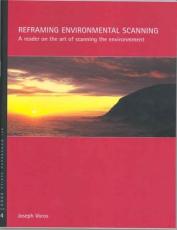One of the principal practices involved in doing futures work is known as ‘scanning’. This term has a few variants — sometimes ‘environmental scanning’, sometimes ‘horizon scanning’, sometimes something else again — and these are often used interchangeably. I prefer to use the term ‘environmental scanning’ when the scanning pertains to the more proximal environment(s) of the organisation or entity that is the primary perspective from which the scanning is done, such as the market or industry in which it sits, while reserving the term ‘horizon scanning’ for the more distal aspects of the wider social, national or even international contexts. This is a fairly loose heuristic, but to me it helps connote the relative ‘closeness’ of the organisation’s ‘operating environment’ vs the relative ‘distance’ of the wider contextual ‘horizon’.
No matter what it’s called, however, the purpose of scanning is to, as it were, look for ‘evidence of the future in the present’. This means, in effect, that we are looking for traces or signals, usually very weak and very early, of how the dynamics occurring in the present might evolve to create the future we will end up living through. And if you think that sounds hard, well, you’re right.
The open secret of foresight work is that scanning is difficult. Futurists Peter Bishop and Andy Hines (2012) have noted (pp.177-78) that:
The scanner is to the future what the lookout is to the sea. Most change does not occur suddenly, out of the blue, even if it appears that way at first. When looking back, one usually finds precursors, signs that the change was coming. Of course those signs are not as clear as the outline of a ship or the blip on a radar screen. In fact, the signs are often so weak that they are ignored completely, until it is too late. … Scanning is part of strategic foresight because it recognizes the inherent uncertainties in preparing for the future and allows people to report plausible outcomes rather than just lock-solid certainties. Despite its obvious utility, scanning is many times more difficult than being the lookout on the ship.
Part of the difficulty of scanning, they argue, is that it is inherently subjective, and the early and weak signals that scanning is looking for are, well, weak and early, so that there is usually very little signal discernible amidst the noise, and usually a long lead time before the change presaged by these signals might mature into something that needs to be dealt with (but also might not). In other words (p.181),
on balance, scanning involves one or more individuals picking up weak and early signs of change, and making subjective judgments based on their knowledge and experience by selecting what they believe are real signs of change in a sea of noise, most of which will probably not amount to anything anyway. … So scanning takes a lot of time that usually does not result in real change anyway. Not only is scanning difficult, therefore, it probably does not get the attention or respect it deserves because the number of hits that result in real change is quite small.
That is reason enough to become disheartened as a futures scanner. But perhaps the real kicker is that (p.181):
The lookout on the ship reports every object that comes over the horizon whether or not it is on a collision course with it. The scanner is held to a different standard, an impossibly high one, in fact, namely “only report the signs of change that will have real consequences for the organization. Don’t bother us with the rest.” Since the standard is impossible to meet, very few people do it. As a result, the organization is essentially blind to the real signs of change out there and surprised when that change suddenly comes upon them.
Yet, despite this difficulty, Bishop and Hines ask (p.181):
So is it worth doing? Put another way, should one be on the lookout for wild animals in a dense forest? The answer, of course, is that people should… .
But, how does one scan? That is the question! Wouldn’t it be good if someone had written a book about it? Oh, wait! *ahem!* Someone has!
This year marks 20 years since I wrote my first serious article for a futures journal — and, as it happens, it was about a new way to do scanning, which reported on my approach to scanning practice back then as a foresight analyst, working in the Office of the Vice-Chancellor at Swinburne. When I moved across from the corporate area to become an academic in the Australian Foresight Institute (which was also at Swinburne), it was then formally published as a monograph in 2003 along with two other papers by world-class experts on scanning to provide a handy guide; it is still freely downloadable today from the university’s ResearchBank at: http://hdl.handle.net/1959.3/34346.
The key argument I make in the introduction to that monograph is that good scanning is much less about what’s ‘out there’ in the world and much more about what’s ‘in here’ in our minds. And that means developing an appropriate mindset is far more important than any specific methods or tools. In posts to come I’ll elaborate more on what I’ve found useful over the 20 years since that first paper, both as a (somewhat) compulsive scanner of the future, and as a teacher of would-be scanners in the old Master of Strategic Foresight. In the meantime, if you’re interested, a quick browse of the monograph would still be a pretty useful intro to what I considered then to be scanning best practice — which, of course, was its very purpose.
References
Bishop, PC & Hines, A 2012, Teaching about the future, Palgrave Macmillan. doi:10.1057/9781137020703.
Voros, J (ed.) 2003, Reframing environmental scanning: A reader on the art of scanning the environment, Australian Foresight Institute Monograph Series, No.4, Swinburne University Press, Melbourne. http://hdl.handle.net/1959.3/34346.
